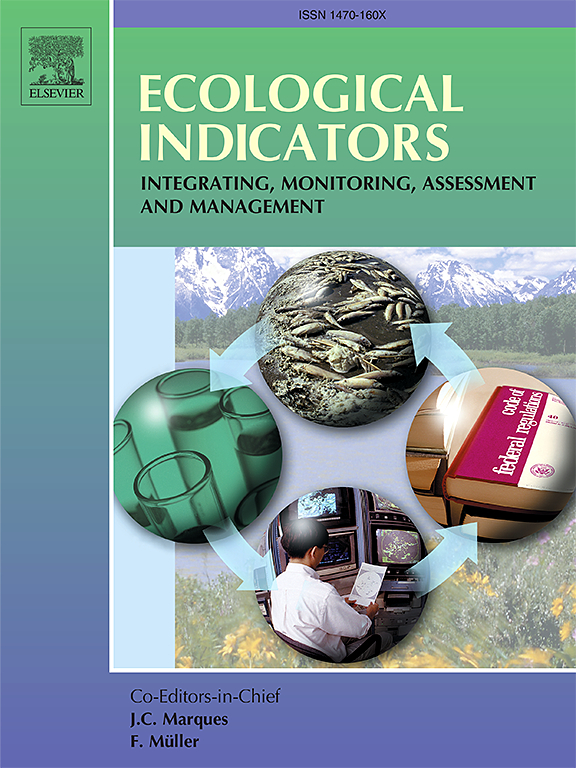基于改进MEDALUS - ESA模型和最优地理探测器的科尔沁沙地沙漠化敏感性多维分析
IF 7
2区 环境科学与生态学
Q1 ENVIRONMENTAL SCIENCES
引用次数: 0
摘要
荒漠化是严重威胁生态系统和区域社会经济发展的全球性生态环境问题。以东北科尔沁沙地为研究对象,利用改进的MEDALUS−EAS模型构建并优化了土地沙漠化敏感性指标体系。它包括五个质量指标:土壤、气候、植被、土地管理和社会经济。层次分析法(AHP)确定因子权重。分析了2000 ~ 2020年沙漠化敏感性的动态变化,并采用最优参数地理探测器对驱动因子进行了分析。结果表明:植被质量指数权重最高(0.4197),其次是气候指数(0.3319)和土壤指数(0.1309),其次是土地管理指数(0.0674)和社会经济指数(0.0502)。2000 ~ 2020年,科尔沁沙地沙漠化敏感性指数在0.0695 ~ 1.0034之间,扭转了这一趋势。极度、高度和中度敏感区域的比例下降,而轻度敏感和非敏感区域的比例稳定或增加。空间分异检测表明,净初级生产力(NPP)和植被覆盖度是显著交互增强的主要驱动力。时空变化检测表明,植被覆盖度和风速在敏感性演化中起主导作用,相互作用强。多因素综合考虑是准确评价的关键,为区域生态治理提供重要参考。本文章由计算机程序翻译,如有差异,请以英文原文为准。
Multidimensional analysis of desertification sensitivity in the horqin sandy land based on an improved MEDALUS − ESA model and an optimal geographical detector
Desertification is a global ecological and environmental problem that seriously threatens ecosystems and regional socioeconomic development. Focusing on the Horqin Sandy Land in Northeast China, this study constructs and optimizes a land desertification sensitivity index system via the improved MEDALUS − EAS model. It covers five quality indices: soil, climate, vegetation, land management, and socio-economy. The analytic hierarchy process (AHP) determines factor weights. We analyzed the dynamic changes in desertification sensitivity from 2000 − 2020and used the optimal parameter geographical detector for the driving factors. The findings show that the vegetation quality index has the highest weight (0.4197), followed by the climate (0.3319) and soil (0.1309) indices, with lower weights for land management (0.0674) and the socioeconomic index (0.0502). The Horqin Sandy Land’s desertification sensitivity index ranged from 0.0695 to 1.0034 from 2000 − 2020, reversing this trend. The proportions of extremely, highly, and moderately sensitive areas decreased, whereas the proportions of slightly sensitive and nonsensitive areas stabilized or increased. Spatial differentiation detection indicates that net primary productivity (NPP) and vegetation coverage are the main drivers of significant interactive enhancement. Spatiotemporal change detection reveals that vegetation coverage and wind speed dominate the evolution of sensitivity, with strong interactions. Multifactor consideration is key for accurate assessment, offering important references for regional ecological governance.
求助全文
通过发布文献求助,成功后即可免费获取论文全文。
去求助
来源期刊

Ecological Indicators
环境科学-环境科学
CiteScore
11.80
自引率
8.70%
发文量
1163
审稿时长
78 days
期刊介绍:
The ultimate aim of Ecological Indicators is to integrate the monitoring and assessment of ecological and environmental indicators with management practices. The journal provides a forum for the discussion of the applied scientific development and review of traditional indicator approaches as well as for theoretical, modelling and quantitative applications such as index development. Research into the following areas will be published.
• All aspects of ecological and environmental indicators and indices.
• New indicators, and new approaches and methods for indicator development, testing and use.
• Development and modelling of indices, e.g. application of indicator suites across multiple scales and resources.
• Analysis and research of resource, system- and scale-specific indicators.
• Methods for integration of social and other valuation metrics for the production of scientifically rigorous and politically-relevant assessments using indicator-based monitoring and assessment programs.
• How research indicators can be transformed into direct application for management purposes.
• Broader assessment objectives and methods, e.g. biodiversity, biological integrity, and sustainability, through the use of indicators.
• Resource-specific indicators such as landscape, agroecosystems, forests, wetlands, etc.
 求助内容:
求助内容: 应助结果提醒方式:
应助结果提醒方式:


